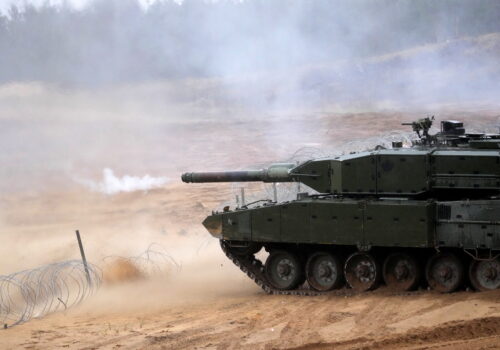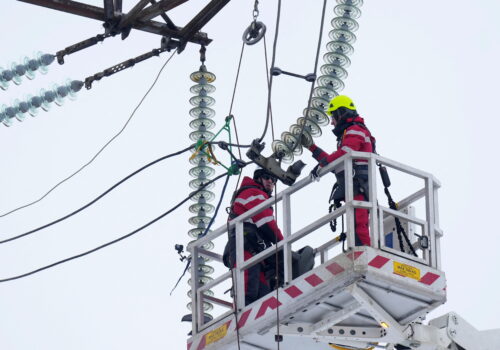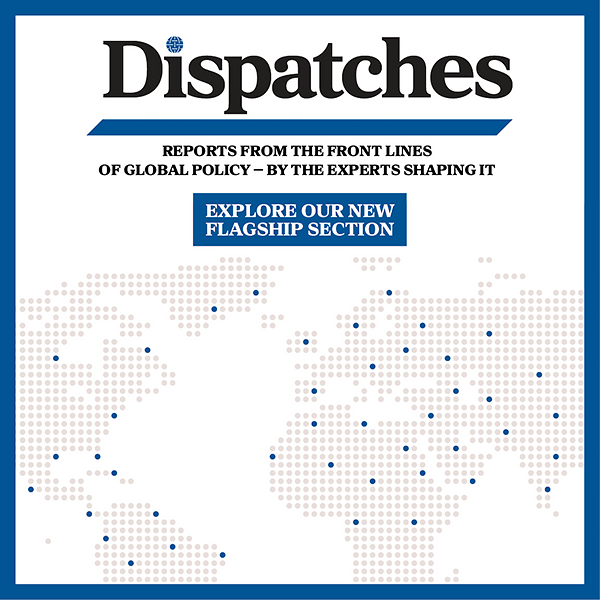Crisis management and resilience: Lessons from Latvia for NATO allies
This project, a collaboration between the Atlantic Council’s Transatlantic Security Initiative and the Latvia-based Centre for East European Policy Studies, aims to advance understanding of Latvia’s defense and security policies, with an emphasis on resilience-building strategies. Latvia’s measures offer lessons for other frontline states, and demonstrate an increasing willingness to prioritize defense in an uncertain geopolitical environment. Read the other articles in this series here and here.
For the past decade, Latvia has faced a set of interlinked challenges that have tested the government’s crisis management and resilience. Russia’s illegal annexation of Crimea in 2014 and its full-scale invasion of Ukraine in 2022 loom large. The COVID-19 pandemic, too, put stress on the system.
And the challenges are not over. Latvian leaders remain concerned that Russia may commit subsequent acts of hybrid or conventional aggression under the guise of protecting ethnic Russians in the Baltic states. But Latvians are also learning from these crises to boost resilience for what comes next.
Three core lessons have been the importance of 1) adopting a whole-of-society approach, 2) increasing clarity on decision-making in times of crisis, and 3) establishing frequent trainings and exercises, as well as cultivating a culture of preparedness. Allies from across NATO can learn from how Latvia has applied each of these lessons.
Responding to the past decade
Positioned on NATO’s eastern flank and sharing borders with Russia and Belarus, Latvia has faced numerous crises involving state and nonstate actors. The country has navigated a range of Russian and Belarusian hybrid threats—cyberattacks, disinformation campaigns, sabotage, and attacks on undersea pipelines in the Baltic Sea. Russia and Belarus have also weaponized migration to the Latvian, Lithuanian, and Polish borders and refugee flows following the invasion of Ukraine. Additionally, the COVID-19 pandemic exposed vulnerabilities in public health infrastructure, crisis preparedness, and coordination among national and international actors, as well as driving the politicization of government decision-making.
In response, Latvia set about overhauling its crisis management, emphasizing comprehensive defense, centralized coordination, and societal resilience. By 2021, Latvia—along with other allies—had officially institutionalized resilience and civil preparedness into NATO’s workstreams. Riga engaged with other allies via the NATO Resilience Committee to exchange lessons and best practices. Today, it hosts NATO’s Strategic Communications Centre of Excellence, which has produced reports and recommendations on disinformation and influence operations. Latvia has also received more than €800 million so far in European Union (EU) support for national recovery and resilience planning, with more funding promised.
A whole-of-society and whole-of-government approach
A key lesson Latvia has applied is the need for a whole-of-society and whole-of-government approach to defense. In a shifting regional security environment, leaders have updated their security and defense strategies. Latvia’s main strategic planning document in the field of security, the National Security Concept, has undergone several iterations since 2011 but has consistently identified foreign threats (including hybrid threats) as top priorities and emphasized the need to strengthen the country’s defense capabilities. The concept has also prioritized “business continuity and resilience,” mandating the creation of plans that clarify who is responsible for what in a crisis.
After Russia annexed Crimea and launched its proxy war in eastern Ukraine in 2014, Latvian decision makers were forced to more realistically assess the country’s ability to defend against both conventional and hybrid threats. Since 2014, the country has gradually increased its defense budget and, as of this year, Latvia contributes more than 3 percent of its gross domestic product to defense, well on its way to The Hague summit pledge of 5 percent by 2035.
The hybrid nature of Russia’s malign actions prompted Latvia to adopt a holistic approach to defense, involving other state sectors in resilience efforts. This whole-of-society approach mitigates the deficiencies of individual state institutions, including limited capacities, small personnel sizes, specialist bottlenecks, and technical limitations—offering lessons for other NATO allies with limited resources.
Latvia’s State Defense Concept of 2016 officially adopted a whole-of-government and whole-of-society approach. The most significant shift, however, came in 2019, with the adoption of the Comprehensive National Defense (CND) system, which required security and crisis preparedness across all sectors, including responding to military conflicts. The CND strengthened civil-military ties through enhanced coordination among military, municipalities, businesses, and nongovernmental organizations. The private sector has also responded in kind, especially following Russia’s full-scale invasion of Ukraine, by supporting military efforts and increasing business resilience. At the same time, the invasion of Ukraine demonstrated the importance of practical defense capabilities and maintaining the integrity of the chain of command.
Clarity in decision-making in moments of crisis
Latvia has also demonstrated the importance of decision-making reform. Leaders opted to amend national security laws and decision-making structures to clarify institutional responsibilities in crises, including territorial attacks. As in most democracies, the most critical decisions regarding the use of armed forces and special security measures are taken by the highest state institutions, such as the Cabinet of Ministers. As of 2014, the government instituted precautionary measures to ensure political decisions could be made even when the cabinet’s work is disrupted. For example, the cabinet can now task the Ministry of Defense to initiate threat mitigation activities, including deploying the military to specific regions. If the cabinet is suddenly incapacitated, the prime minister assumes decision-making authority. And if the prime minister is unable to act, then the responsibility falls to the minister of defense. Prior to this change, only the cabinet could make such decisions.
Latvia has also improved integration between state institutions and the private sector, such as developing clearer response algorithms. However, with hybrid attacks becoming more common, allies should develop closer coordination between state institutions and military, municipal, private-sector, and nongovernmental organizations on shared planning and response frameworks that can be activated in crises. This is important for allies of any size or resource capacity, as crises can range dramatically in scale.
Regular training, exercises, and developing a culture of preparedness
Another important lesson is the need for regular training involving both civilian and military actors. As a 2021 RAND report notes, such training should include diverse actors in different configurations and across multiple levels (local, regional, national, and multilateral). In addition to government officials, relevant officials from private industry, including utility companies, airports, and the defense industry, should be invited, as well.
A key responsibility of Latvia’s Crisis Management Center (CMC), which was established in early July and is overseen by the prime minister, will be the planning and execution of national-level exercises that include top-level decision makers; such exercises will complement existing activities and NATO’s Crisis Management Exercises. One of the authors has observed that sometimes NATO allies and officials deviate from the Alliance’s crisis response system or are unfamiliar with the steps outlined in the manual. This underscores the importance of frequent exercises. While working for the Latvian government, one of the authors observed that political interests sometimes overrule expert advice during crises. This suggests a need for a coherent “crisis management culture.” Mandates are not enough; crisis management requires established institutional practices, training, exercises, and an improved culture. Those participating in exercises need to be the actual individuals who would be responding to a crisis, not lower-level personnel. Regular exercises and training reveal coordination problems and provide opportunities to fix them.
Allies need to proactively develop a culture of preparedness. Such efforts range from actions focused on building up resilience by civilian and military actors within the government—from the hyper-local to national levels—all the way up to closer engagement on resilience efforts via multilateral frameworks. The latter requires frequent communication with the private sector and the public sector alike. For business leaders, this means concrete conversations about divisions of labor, which essential services can and cannot be restored and in what timeframes, which systems are back-up systems, and who should step in for which functions in an emergency.
Looking ahead: Reforming Latvia’s crisis management system
Even with its advances in recent years, Latvia has significant room to improve its crisis management system. As the State Audit Office noted after the COVID-19 pandemic, the system required clearer delineations of institutional responsibility, better alignment of plans with real-world conditions and available resources, increased investment in critical material reserves, and, importantly, a need for regular interagency exercises.
Thankfully, Latvia is reforming its crisis management system. At the center of this reform is the creation of the CMC. Among its core functions is gathering and analyzing real-time information to identify and assess potential risks and threats. The CMC will be primarily focused on the nonmilitary domain, and it will support the work of the Crisis Management Council, prepare draft decisions for government approval, and coordinate institutional actions during large-scale crises. It will also plan the country’s material reserves.
Despite its small size, Latvia demonstrates that it can respond swiftly and decisively by aligning national efforts with broader EU and NATO resilience frameworks. Strengthening resilience also positions Latvia as a reliable ally within NATO and the EU, reinforcing the Alliance’s overall deterrence posture and highlighting the importance of solidarity in an increasingly volatile security environment. The coordination of civilian crisis response still needs improvement. Both the COVID-19 pandemic and the 2021 migration crisis demonstrated the need to increase coordination between state institutions, clarify institutional responsibilities, and establish institutions that can monitor threats 24/7 and coordinate responses.
Latvia’s experience offers an example of how a small state can respond to complex, hybrid crises. The crisis management reforms that Latvia has already implemented signal growing resilience. True resilience requires institutional shifts, preparedness, coordination, regular training, and public trust. As threats evolve—from pandemics to cyberattacks to geopolitical confrontations—Latvia’s path demonstrates both the vulnerabilities that countries face and the potential for democratic crisis governance to overcome them.
Heidi Hardt is a nonresident senior fellow at the Transatlantic Security Initiative of the Atlantic Council’s Scowcroft Center for Strategy and Security and an associate professor of political science at the University of California, Irvine.
Māris Cepurītis is the director of the Center for Eastern European Policy Studies and a lecturer at Riga Stradins University.
Further reading
Wed, May 14, 2025
Inside Latvia’s race against time to build deterrence against Russia
New Atlanticist By
Latvia must convince its NATO allies to commit the necessary resources for its defense before Russia reconstitutes its forces.
Wed, May 7, 2025
Lessons from Latvia’s efforts to keep essential services running during a crisis
New Atlanticist By
Latvia has shifted its crisis-management thinking from a focus on infrastructure protection to an emphasis on continuity of essential services and functions.
Fri, Jun 27, 2025
Four fundamental questions the NATO Summit did not answer
New Atlanticist By Torrey Taussig
Over the coming months, NATO allies will have to wrestle with questions about the US commitment to Europe, their shared approach to China, and more.
Image: People hold giant flag with NATO sign as Latvia celebrates anniversary to joining alliance in Riga, Latvia March 28, 2024. REUTERS/Ints Kalnins



